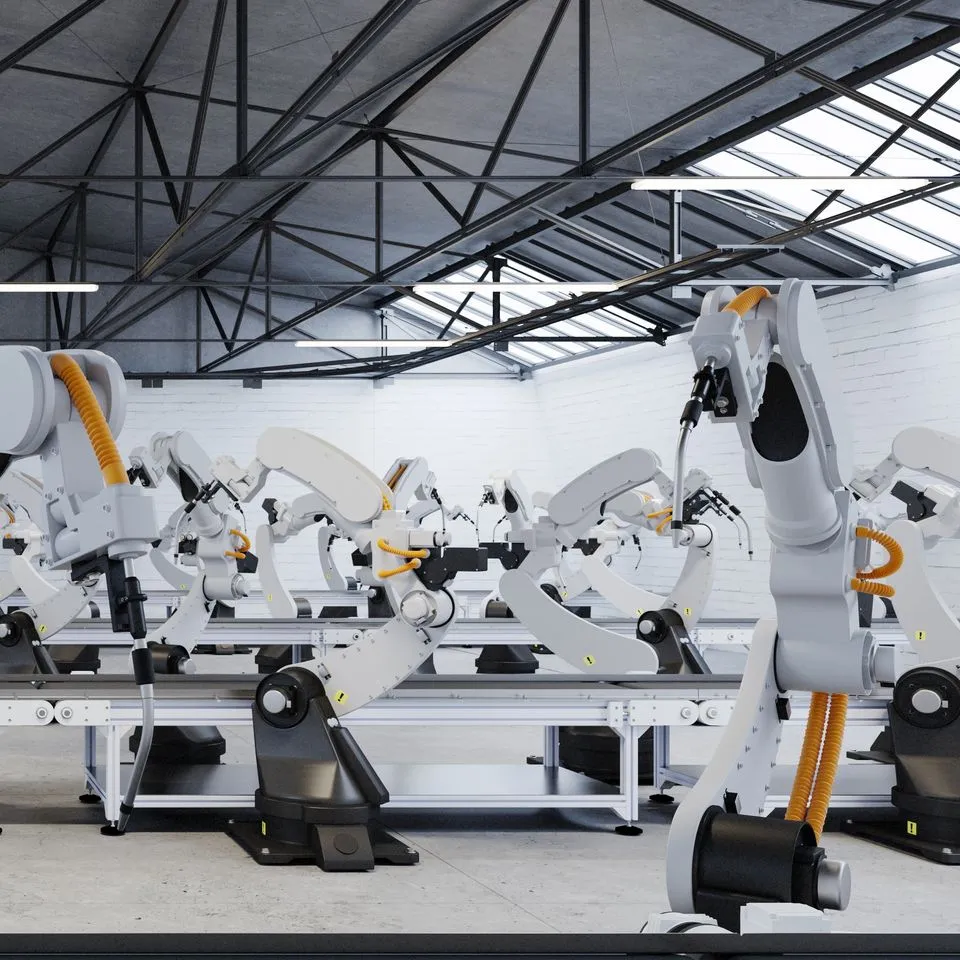Securing The Future: The New Energy Landscape for Commercial and Industrial Companies


Introduction
The energy landscape in the United States is undergoing a paradigm shift. For the past 100+ years, energy production and consumption has been a one-way system, where energy was produced, managed, and distributed by grids and utilities to consumers – commercial, industrial, residential, transportation and others. Now, this system is being rapidly disrupted, evolving from a centralized set of systems anchored by major utilities to a decentralized set of ecosystems where the typical energy customer can now become an energy producer as well as a consumer.
This shift is being driven by various factors such as technological advancements, environmental concerns, policy developments, and changing consumer preferences. Supporting this new energy ecosystem is the proliferation of distributed energy resources (DERs), such as rooftop solar panels, small wind turbines, energy storage systems, and other localized energy generation and management technologies, all of which are helping reshape the energy landscape. These resources enable individual consumers, businesses, and communities to generate their own electricity, reduce grid dependence, and contribute to a more decentralized energy system.
A history of integrating natural resources into the built environment
Designing a built environment that integrates natural resources is a practice that spans back thousands of years, dating almost to the very origins of human-made structures. Throughout history, architects and engineers have recognized the inherent benefits of incorporating natural resources into their designs, whether using locally available materials, harnessing natural light and ventilation, or leveraging renewable energy sources.
Ancient civilizations, such as the Egyptians, Persians, Greeks, and Romans, embraced the concept of integrating natural resources into their architectural designs. They constructed buildings using materials found in their surroundings, such as stone, wood, and earth, taking advantage of their durability and thermal properties. These ancient architects also employed innovative design techniques including strategic orientation and spatial planning to optimize sunlight and air circulation within structures, creating comfortable living environments without relying on modern mechanical systems.


The concept of integrating natural resources into built environments has gained renewed attention in the context of sustainable and green building practices. Contemporary architects and engineers are exploring innovative ways to design structures that leverage natural resources to minimize environmental impact and maximize energy efficiency. This includes incorporating features such as green roofs and living walls to improve insulation and reduce stormwater runoff, utilizing passive solar design principles to optimize heating and cooling, and integrating renewable energy systems like solar panels or wind turbines to generate clean energy on-site.
The integration of renewable energy sources into commercial and industrial facilities has become a game-changer in the quest for sustainable energy solutions. The utilization of solar panels, wind turbines, and geothermal systems not only reduces reliance on traditional fossil fuel sources but also allows buildings to be designed to generate clean, renewable energy on-site. This shift towards renewable energy sources promotes carbon neutrality, reduces greenhouse gas emissions, and creates a more resilient and sustainable energy infrastructure for commercial and industrial facilities.
Revolutionizing the Grid: Advancements in DERs and Renewable Energy
Today, DERs such as battery energy storage technologies are rapidly advancing with groundbreaking progress in the development of advanced batteries. The most recent iterations of grid scale storage batteries have shown great improvements in capacity, efficiency, and durability. These energy storage systems are enabling the efficient integration of intermittent renewable energy sources, providing grid stabilization services, enhancing energy resilience, and facilitating load shifting. They also play a critical role in balancing supply and demand, supporting the growth of renewable energy, and improving the overall reliability and flexibility of the grid.
Another aspect of DERs include renewable energy sources, including solar, wind, and hydropower, all of which are experiencing significant growth in the United States. Decreasing costs, supportive policies, and increased public awareness of climate change have accelerated the deployment of renewable energy projects across the country. Renewables are becoming a more significant portion of the electricity generation mix, reducing reliance on fossil fuels and contributing to emissions reductions.
Accelerating Electrification: U.S. Transportation Sector Drives Grid Transformation
With its accelerating shift toward electrification, the U.S. transportation sector is another contributing factor to grid transformation. The U.S. market for electric vehicles (EVs) has grown rapidly in recent years, supported by expanding charging infrastructure, government incentives, and advances in battery technology. According to registration data from Experian, the total number of Battery Electric Vehicles in the U.S. increased by 257,507 in Q1 2023, an increase of 63 percent year over year and 7% of the total new vehicle market (up from 4.6% in Q1 2022) 1. In the short-term, this trend towards transportation electrification reduces reliance on fossil fuels and lowers carbon emissions. However, the widespread adoption of electric vehicles (EVs) is leading to an increase in electricity demand as EV charging adds new loads to the grid, particularly during peak charging times. This increased demand for electricity will require careful planning and management to ensure grid stability and avoid overloading local distribution infrastructure.
Recent U.S. federal initiatives and commitments are helping to drive adoption of new policies that support the financing of the energy transition. The Inflation Reduction Act, passed in August 2022, contains over $370 billion in clean energy incentives, loans, and other programs, supporting the rapid growth of clean energy technologies and industries. Many states have also implemented renewable portfolio standards, clean energy goals, and carbon reduction targets. The digital modernization of the U.S. electric grid is essential for accommodating the rapidly changing energy landscape in the U.S. Strong collaboration and substantial investments in smart grid infrastructure, digital technologies, and grid analytics will play an essential role in enabling real-time monitoring, grid optimization, integration of DERs, and improving grid reliability and resilience. Grid modernization efforts will also require the integration of advanced metering infrastructure, energy management systems, and greater grid flexibility.
The Impact of the Commercial and Industrial Sector on the United States Economy and Carbon Emissions
The Commercial and Industrial (C&I) sector is one of the largest consumers of energy in the United States. In 2020, the C&I sector consumed about 48% of the nation’s total energy usage2. According to the U.S. Energy Information Administration, energy consumption in the industrial sector is estimated to increase between 5% and 32% between 2022 and 20503. This energy consumption contributes to carbon emissions and affects overall energy demand.


Energy consumption in general is influenced heavily by economic growth – as the economy grows, so does energy consumption. For the C&I sector, several other key factors play a role:
- Size and Diversity: The C&I sector encompasses a wide range of industries, including manufacturing, construction, transportation, services, and commercial buildings. These industries have diverse energy needs and often require substantial energy inputs to power their operations, machinery, equipment, lighting, heating, cooling, and other processes.
- Industrial Processes: Industrial activities within the C&I sector involve energy-intensive processes such as manufacturing, refining, and chemical production. These processes often require the use of heavy machinery, high-temperature operations, and large-scale operations, all of which necessitate significant energy consumption.
- Building Energy Demand: Commercial buildings, including office buildings, shopping malls, hotels, and hospitals, require substantial energy to meet their heating, cooling, lighting, and ventilation needs. The energy demands of these buildings are typically higher compared to residential buildings due to their larger size, complex systems, and continuous operation.
- Operational Hours: Many industries within the C&I sector operate on a 24/7 basis, leading to constant energy consumption. Production lines, manufacturing plants, and other facilities often require uninterrupted energy supply to maintain operations, resulting in a continuous energy demand.
- Equipment and Machinery: The C&I sector utilizes a wide array of energy-consuming equipment and machinery, including motors, pumps, compressors, refrigeration units, and industrial-scale appliances. These equipment types are essential for various industrial processes and tend to consume significant amounts of energy.
- Technology and Automation: As industries evolve and adopt advanced technologies and automation, energy consumption may increase. While modern technologies may offer energy-saving benefits, the overall energy demand can rise due to increased automation, digitalization, and the integration of energy-consuming systems.
- Economic Growth and Industrial Development: The growth of the C&I sector is closely linked to economic expansion. As industries thrive, demand for products and services increases, leading to greater energy needs for production, transportation, and supporting infrastructure.
While efforts are underway to improve energy efficiency, promote renewable energy adoption, and implement sustainable practices within the C&I sector, its inherent characteristics, diverse energy requirements, and scale contribute to its significant energy consumption in the United States.


All economic sectors in the United States have experienced a slight downward trend in CO2 emissions over past two decades. Transportation, however, experienced the least decline of the sectors until dropping sharply in 2020 due to the COVID-19 pandemic.
The C&I Sector’s Influence on the U.S. Economy
In addition to and because of its impact on energy use and carbon emissions, the C&I sector also plays a vital role in the US economy. In 2022, it accounted for approximately 43.4% of the nation’s GDP4. The sector encompasses a wide range of industries, including manufacturing, construction, and mining.


The C&I sector is a major employer in the United States, providing jobs across various industries, and supporting millions of workers. In 2020, the sector employed approximately 33.3 million people5.
The sector also drives investment and innovation, research and development, technology advancements, and infrastructure development, fostering economic progress, and playing a crucial role in international trade. It is responsible for a significant portion of the country’s exports, contributing to the balance of trade and promoting economic competitiveness.
The C&I Sector’s Contribution to Carbon Emissions
As the largest contributor to carbon emissions compared to all other sectors, the Commercial and Industrial (C&I) sector has substantial environmental and economic impacts in the United States. In 2022, these sectors accounted for approximately 32% of the country’s total carbon emissions, compared to transportation at ~27%, electric power at ~23% and the residential sector at ~14%6.
The Energy Transition: From Centralized / Consumer to Decentralized / Prosumer
Driven by advancements in technology, changing and availability of new clean energy sources, and evolving consumer preferences, the energy grid in the United States is undergoing a transition from a centralized model to a decentralized model. This transition is often referred to as “grid modernization” or “grid transformation.”
Decentralization of the energy grid allows commercial and industrial companies to enhance their energy resilience. By generating electricity on-site or having access to localized energy sources, such as solar panels or wind turbines, C&I entities can reduce their reliance on centralized power plants and transmission infrastructure. This enables them to maintain operations even during grid disruptions or power outages, ensuring business continuity.
Decentralized energy systems can lead to potential cost savings for C&I companies. On-site renewable energy generation, such as solar PV systems, can help reduce electricity bills by offsetting grid electricity consumption. Additionally, decentralized systems allow businesses to take advantage of net metering programs, where excess electricity generated on-site is fed back into the grid, resulting in credits or reduced electricity costs.
Adopting a decentralized energy model provides commercial and industrial companies with greater energy independence. By generating their own electricity or procuring it from local sources, businesses have more control over their energy supply. This reduces exposure to price volatility in the centralized grid and minimizes the risks associated with dependence on a single energy provider.
Decentralization of the energy grid aligns with sustainability goals for commercial and industrial entities. On-site renewable energy generation reduces carbon emissions, lowers environmental impact, and demonstrates a commitment to clean energy. By reducing reliance on fossil fuel-based power generation, C&I companies can contribute to local and national climate change mitigation efforts.
A decentralized grid allows for more effective demand response programs, allowing C&I companies to actively manage their electricity usage and respond to grid conditions or price signals. By adjusting energy consumption during peak demand periods, businesses can contribute to grid stability, support the integration of intermittent renewable energy sources, and potentially receive financial incentives for their participation.
The shift toward a decentralized grid encourages technological innovation and the development of new energy solutions. This presents commercial and industrial companies with opportunities to shift from a “consumer” role – one of consuming energy from the grid – to a “prosumer” role – that of consuming, producing and contributing energy back to the grid. This will require the adoption of advanced technologies such as energy storage systems, smart grid infrastructure, and energy management software. These innovations can optimize energy usage, improve operational efficiency, and enhance cost savings for C&I entities, as well as potentially drive revenue.
The future grid will need to accommodate growing supply volatility from intermittent resources and quickly-evolving fuel infrastructures, as well as increased demand-side functionality with distributed energy resources and the electrification of transportation, buildings, and industry. These trends will create significant new opportunities for technologies that decouple legacy dependencies and increase grid flexibility.
C&I Opportunities for Resilient, Reliable and Flexible Energy Management
There are multiple opportunities for Commercial and Industrial (C&I) entities to achieve resilient, reliable, and flexible energy management. Key areas where C&I companies can focus their efforts include:
- Energy Storage Solutions: Energy Storage systems allow C&I entities to store excess electricity during periods of low demand and use it during peak demand or grid disruptions. Energy storage enhances resilience by providing backup power, load shifting capabilities, and grid stabilization services. It can also help optimize energy usage, reduce demand charges, and participate in demand response programs.
- Microgrids provide C&I companies with localized power generation, distribution, and control capabilities. Microgrids can operate independently or in conjunction with the main grid and offer increased resilience, reliability, and flexibility. A study by the U.S. Department of Energy (DOE) found that microgrids can improve power reliability by reducing the average number of outages by 70-80%7
By integrating renewable energy sources, energy storage, combined heat and power (CHP) systems, and advanced controls, microgrids can enhance energy management and minimize disruptions during grid outages or disturbances and maximize efficiency. According to a report by the National Renewable Energy Laboratory (NREL), microgrids can achieve energy efficiency gains of 15-30% compared to traditional grid-connected systems8.
The Clean Energy Group reported that microgrids with high renewable energy penetration can achieve carbon emission reductions of up to 90% compared to conventional energy systems9.
- Demand Response Programs: Participating in demand response programs allows C&I companies to actively manage their electricity usage and reduce demand during peak periods. By curtailing or shifting non-critical loads, businesses can support grid stability, avoid costly peak demand charges, and potentially earn financial incentives. Advanced energy management systems and real-time energy monitoring enable effective participation in demand response initiatives.
- Smart Energy Management Systems: Deploying advanced energy management systems and technologies allows C&I companies to monitor, analyze, and optimize energy usage in real-time. These systems integrate energy data, automate control strategies, and enable predictive analytics for more efficient energy management. Smart systems can facilitate load balancing, demand response participation, and real-time decision-making, enhancing resilience and flexibility.
- Renewable Energy Integration: Increasing the integration of renewable energy sources, such as solar PV systems or wind turbines, provides C&I entities with reliable and sustainable power generation options. On-site renewable energy installations can reduce reliance on the grid, hedge against price volatility, and contribute to environmental goals. Combining renewable energy generation with energy storage systems enhances flexibility and resilience.
- Energy Management Software and Analytics: Utilizing energy management software and analytics tools enables C&I entities to implement strategies to reduce costs and environmental impact by tracking energy usage, identifying inefficiencies, and optimizing energy performance. Real-time monitoring, data analytics, and reporting features help identify energy-saving opportunities, detect anomalies, and enable informed decision-making. These tools enable proactive energy management and improve operational reliability. It includes measures like load management, energy efficiency improvements, and demand response programs. A survey conducted by Deloitte found that 79% of C&I respondents had an energy management strategy in place, and 89% viewed reducing energy costs as essential to staying competitive10.
- Energy as a Service (EaaS): EaaS offers a comprehensive approach to energy management, where a third-party provider assumes responsibility for the energy infrastructure, operations, and maintenance. It allows C&I customers to focus on their core business while accessing reliable and cost-effective energy solutions. According to a report by Navigant Research, the global EaaS market is expected to reach $101.4 billion in revenue by 2026, driven by increasing demand for energy efficiency, sustainability, and innovative financing models11.
- Energy Efficiency Measures: Implementing energy efficiency measures is an important aspect of resilient and reliable energy management. By optimizing equipment, processes, and building systems, C&I entities can reduce overall energy consumption, lower costs, and minimize the strain on the energy grid. Energy audits, retrofits, and the adoption of energy-efficient technologies help enhance operational efficiency and sustainability.


By leveraging these opportunities for resilient, reliable, and flexible energy management, C&I entities can enhance their operational efficiency, reduce energy costs, improve grid resilience, and contribute to a sustainable energy future. It’s important to conduct energy audits, assess specific energy needs, and collaborate with energy service providers or consultants to develop tailored strategies that align with the unique requirements of each organization.
These solutions collectively enable the C&I sector to achieve various benefits, including reduced energy costs, improved energy efficiency, enhanced grid reliability, and increased utilization of renewable energy sources.
Integrating natural and renewable resources into the built environment has a rich and enduring history, spanning back to ancient times. Today, sustainable outcomes and human-centric design have become imperative, and designers, architects and engineers are at the forefront of exploring ways to incorporate innovative technologies into our environments.
By leveraging these opportunities for resilient, reliable, and flexible energy management, C&I entities can enhance their operational efficiency, reduce energy costs, improve grid resilience, and contribute to a sustainable energy future. It’s important to conduct energy audits, assess specific energy needs, and collaborate with energy service providers or consultants to develop tailored strategies that align with the unique requirements of each organization.
These solutions collectively enable the C&I sector to achieve various benefits, including reduced energy costs, improved energy efficiency, enhanced grid reliability, and increased utilization of renewable energy sources.
Integrating natural and renewable resources into the built environment has a rich and enduring history, spanning back to ancient times. Today, sustainable outcomes and human-centric design have become imperative, and designers, architects and engineers are at the forefront of exploring ways to incorporate innovative technologies into our environments.
Hitachi’s Energy Expertise
Hitachi has extensive expertise and experience with the commercial and industrial manufacturing sectors. Our energy capabilities include microgrids, DERs, battery energy storage solutions, and digital energy management solutions. We work closely with partners to provide flexible financing solutions and assist with identifying incentives, loans and programs that can help offset the costs of installing renewable energy and energy storage solutions. With a proven track record of over 250 global energy installations, Hitachi serves a range of applications, including remote communities, islands, utilities, and commercial and industrial customers. As a leading provider of microgrid products and solutions, Hitachi offers a comprehensive approach, from initial consultancy to remote monitoring.
Hitachi’s energy solutions are built on flexible and scalable platforms, supporting power demands ranging from a few hundred kilowatts to several megawatts. Additionally, Hitachi’s solutions enable remote monitoring, data collection, and advanced analytics, allowing users to access forecasting, optimization, diagnostics, and analytics for enhanced performance.
1 US: All-Electric Car Sales Increased In Q1 2023: 257,000 Registrations https://insideevs.com/news/667516/us-electric-car-sales-2023q1/#:~:text=According%20to%20the%20registration%20data,4.6%20percent%20in%20Q1%202022
2 U.S. Energy Information Administration / Monthly Energy Review May 2023 https://www.eia.gov/totalenergy/data/monthly/pdf/sec11.pdf
3 U.S. Energy Information Administration (EIA) – Today in Energy: https://www.eia.gov/todayinenergy/detail.php?id=56040
4 Gross Domestic Product (Third Estimate), Corporate Profits, and GDP by Industry, Fourth Quarter and Year 2022 https://www.bea.gov/sites/default/files/2023-03/gdp4q22_3rd.pdf
5 U.S. Bureau of Labor Statistics (BLS) – Current Employment Statistics Highlights: https://www.bls.gov/web/empsit/ceshighlights.pdf
6 U.S. Environmental Protection Agency (EPA) – Greenhouse Gas Emissions: https://www.epa.gov/ghgemissions/sources-greenhouse-gas-emissions
7 U.S. Department of Energy (DOE). (2017). Microgrid Market Assessment and Analysis. https://www.energy.gov/sites/default/files/2018/01/f46/GMI%20Peer%20Review%20Report%202017_1-22%20FINAL%20online.pdf
8 National Renewable Energy Laboratory. (2021) Microgrids, Infrastructure Resilience, and Advanced Controls Launchpad https://www.nrel.gov/docs/fy22osti/81792.pdf
9 Clean Energy Group. (2015) What States Should Do: A Guide to Resilient Power Programs and Policy
https://www.cleanegroup.org/wp-content/uploads/Resilient-States.pdf
10 Deloitte. (2019). Resources 2019 Study: Business and Industry’s views of the energy landscape.
11 Navigant Research. (2021). Energy as a Service Market Overview.
Microgrid Solution | Johannesburg, South Africa | Providing Uninterrupted Power Supply


Challenge
Uninterrupted power supply is critical in the region, and it is specifically important for commercial industries and factories to operate – even during load shedding. By integrating renewable energy resources like sun, wind and hydro into the power grid, the potential loss of power can be avoided. Hitachi Energy’s solution serves the power demand of the facility by using renewable energy, even in the event of load shedding. It has full on- and off-grid functionalities and prioritizes renewable energy before using the existing diesel generators. This environmentally friendly solution contributes to a reduction of carbon emissions, substantially reducing the operational cost of the industrial complex.


Solution
The microgrid solution in South Africa is constructed for the 96,000-square-meter Longmeadow facility that is hosting Hitachi Energy South Africa’s headquarters as well as manufacturing facilities. It consists of a 1 MVA/380 kWh e-meshTM PowerStoreTM and e-mesh control, which together with a 750 kW rooftop photovoltaic (PV) field have been added to the existing backup solution. The microgrid technology deployed at Longmeadow is fully containerized and pre-designed for this type of application. In urban areas, C&I firms are now implementing low-carbon microgrids, particularly in commercial facilities requiring consistent power such as hospitals and malls.


Uninterrupted power supply
The e-mesh PowerStore and Control solution enable continuity of electricity supply even when the main grid is disrupted. The supply also maintains its stability during transitions from grid to island operation. By utilizing this technology, buildings, plants and factories can run normally through any power outage enabling increased productivity, security and cost efficiency.
Integration of renewables – leveraging the “power of the sun”
The solution optimizes renewable energy contribution to the facility and reduces the CO2 emissions by over 1,000 tons/year. The innovative system with fully grid-connected and off-grid functionalities helps maximize the use of clean solar energy and ensures an uninterrupted power supply. It provides cost-effective access to high-quality power while minimizing environmental impact by reducing the use of diesel generation.
Roxana Moolla
Director Marketing & Communications, Environment Business Division, Hitachi
Roxana is responsible for marketing, communications and customer acquisition for sustainability initiatives at Hitachi; she is also an author, an inventor with 5 patents and a GRI Certified Sustainability Professional. As an architect, she led the design, development and construction of several large-scale developments in Canada. Roxana holds a Bachelor of Environmental Studies from the University of Manitoba and a Bachelor of Architecture from the University of Arizona, and has British, Canadian and US citizenships.


Learn more about Hitachi energy solutions
For further information on how Hitachi’s energy solutions can help C&I companies with resilient, reliable, and flexible solutions, contact us.
Contact Us
* Required Field



